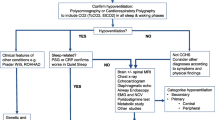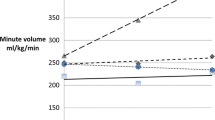Abstract
Background
Congenital central hypoventilation syndrome (CCHS) is a rare condition that usually presents soon after birth and is potentially life-shortening if not treated. The defining abnormality is hypoventilation during sleep which requires life-long treatment with artificial ventilation. This syndrome may also be associated with generalised dysfunction of the autonomic nervous system and a sub-group with associated Hirschsprung’s disease. The genetic basis of CCHS has been identified as mutations in the PHOX2B gene.
Methods
We present four families, three with autosomal dominant inheritance and familial clustering, and one with a de novo mutation resulting in CCHS.
Conclusions
We demonstrate that nasal mask ventilation from birth can provide adequate treatment and improved quality of life for these children. Phenotypic variability in expression of disease is seen in families with the same mutations in PHOX2B gene. The psychosocial costs of the disease and the unrecognised ‘morbidity barter’ that is part of current management needs to be factored into in all stages of management from childhood to adolescence to adulthood.
Similar content being viewed by others
References
Vanderlaan M, Holbrok CR, Wang M, Tuell A, Gozal D (2004) Epidemiologic survey of 196 patients with congenital central hypoventilation syndrome. Pediatr Pulmonol 37:217–229
Autonomic control, congenital failure of. MIM#209880. http://www.ncbi.nlm.nih.gov/omim/209880, accessed on 08/05/2010
Gaultier C, Amiel J, Dauger S, Trang H, Lyonnet S, Gallego J, Simonneau M (2004) Genetics and early disturbances of breathing control. Pediatr Res 55:729–733
Berry-Kravis EM, Zhou L, Rand CM, Weese-Mayer DE (2006) Congenital central hypoventilation syndrome: PHOX2B mutations and phenotype. Am J Respir Crit Care Med 74:1139–1144
Hamilton J, Bodurtha JN (1989) Congenital central hypoventilation syndrome and Hirschsprung's disease in half sibs. J Med Genet 26:272–274
Weese-Mayer DE, Berry-Kravis EM (2004) Genetics of congenital central hypoventilation syndrome: lessons from a seemingly orphan disease. Am J Respir Crit Care Med 170:16–21
Antic NA, Malow BA, Lange N, McEvoy RD, Olson AL, Turkington P, Windisch W, Samuels M, Stevens CA, Berry-Kravis EM, Weese-Mayer DE (2006) PHOX2B mutation—confirmed congenital central hypoventilation syndrome presentation in adulthood. Am J Respir Crit Care Med 174:923–927
Silvestri JM, Weese-Mayer DE, Nelson MN (1992) Neuropsychologic abnormalities in children with congenital central hypoventilation syndrome. J Pediatr 120:388–393
Bachetti T, Matera I, Borghini S, Di Duca M, Ravazzolo R, Ceccherini I (2005) Distinct pathogenic mechanisms for PHOX2B associated polyalanine expansions and frameshift mutations in congenital central hypoventilation syndrome. Hum Mol Genet 14:1815–1824
Matera I, Bachetti T, Puppo F, Di Duca M, Morandi F, Casiraghi GM, Cilio MR, Hennekam R, Hofstra R, Schober JG, Ravazzolo R, Ottonello G, Ceccherini I (2004) PHOX2B mutations and polyalanine expansions correlate with the severity of the respiratory phenotype and associated symptoms in both congenital and late onset central hypoventilation syndrome. J Med Genet 41:373–380
Chen ML, Keens TG (2004) Congenital central hypoventilation syndrome: not just another rare disorder. Paediatr Respir Rev 5:182–189
Villa MP, Dotta A, Castello D, Piro S, Pagani J, Palamides S, Ronchetti R (1997) Bi-level positive airway pressure (BiPAP) ventilation in an infant with central hypoventilation syndrome. Pediatr Pulmonol 24:66–69
Ramesh P, Boit P, Samuels M (2008) Mask ventilation in the early management of congenital central hypoventilation syndrome. Arch Dis Child Fetal Neonatal Ed 3:F400–F403
Li KK, Riley RW, Guilleminault C (2000) An unreported risk in the use of home nasal continuous positive airway pressure and home nasal ventilation in children. Chest 117:916–918
Todd ES, Weinberg SM, Berry-Kravis EM, Silvestri JM, Kenny AS, Rand CM, Zhou L, Maher BS, Marazita ML, Weese-Mayer DE (2006) Facial phenotype in children and young adults with PHOX2B-determined congenital central hypoventilation syndrome: quantitative pattern of dysmorphology. Pediatr Res 59:39–45
Hennewig U, Hadzik B, Vogel M, Meissner T, Goecke T, Peters H, Selzer G, Mayatepek E, Hoehn T (2008) Congenital central hypoventilation syndrome with hyperinsulinism in a preterm infant. J Hum Genet 53:573–577
Author information
Authors and Affiliations
Corresponding author
Rights and permissions
About this article
Cite this article
Trivedi, A., Waters, K., Suresh, S. et al. Congenital central hypoventilation syndrome: four families. Sleep Breath 15, 785–789 (2011). https://doi.org/10.1007/s11325-010-0439-z
Received:
Revised:
Accepted:
Published:
Issue Date:
DOI: https://doi.org/10.1007/s11325-010-0439-z




